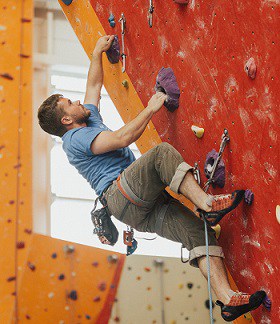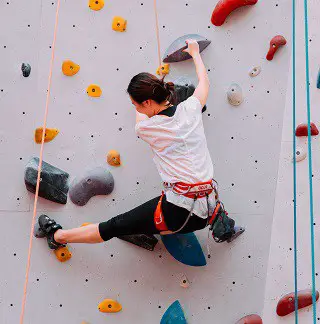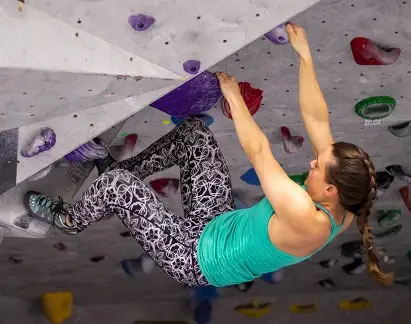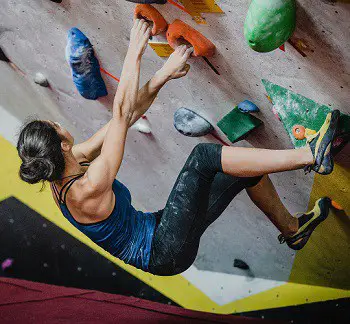Disclosure: Links marked with * are Affiliate Links. As an Amazon Associate, I earn from qualifying purchases if you decide to make a purchase through these links – at no cost for you!
You want to climb in a climbing gym and ask yourself what you should wear?
In principle, it’s quite simple. For the first few sessions, normal sportswear is perfect for climbing indoors. Your clothes should not restrict your freedom of movement or get tangled up in ropes. Men usually wear T-shirts with comfortable shorts and women wear tops with leggings or yoga pants.
Once you get a taste for climbing, your next investment should definitely be climbing chalk* in a stylish chalk bag* for a better grip on the wall.
To start with, you can rent shoes from the climbing gym, but later you should buy your own climbing shoes* to save money and to have a better feeling in your feet and on the wall.
In this article, we go over all the basics about how to dress best for indoor climbing and what you should take with you to the climbing gym later as additional equipment.
Here are a few examples of ideal clothing for a climbing gym:
The Basics: Basic Clothing for Climbing Indoors
Climbing indoors has one big advantage over the outdoor variant – you are largely independent of the weather. You don’t need rain gear, thick sweaters or jackets, and you don’t have to adjust your clothes for functionality with the weather.
The most important thing about climbing clothing is that it does not restrict your freedom of movement. Fitness clothes are best because they are usually made of stretch material and do not interfere with your movements.
But a normal T-shirt and comfortable pants or shorts are also perfectly sufficient. As long as your clothes do not restrict your freedom of movement, you are relatively free in what you wear. However, you should take care that your clothes are not too bulky so that you don’t get caught in the rope or anywhere else.
So if you already own a few sports clothes, you’re almost ready to go! The only thing missing is magnesia/climbing chalk and optional your own climbing shoes (further down in the article I’ll go into this further).
Most men wear T-shirts and comfortable shorts. Women mostly wear sports bras, normal tops and yoga pants.
Here are a few criteria you should consider when choosing clothes for climbing in a climbing gym:
- Flexibility: When climbing, you often have to stretch to distant grips. You need your complete physical flexibility. Your clothes shouldn’t interfere. If, for example, you have jeans that are a little too tight and do not allow complete legroom, you will quickly become frustrated or destroy your jeans during a move.
- A tight fit is usually better: By tight fit, I don’t necessarily mean that you press yourself into your clothes as if there are like a second skin, but that it sits loosely but doesn’t stand too far away from your body. If you’re wearing a sweater that’s too big or baggy jeans, you can quickly get stuck somewhere. In addition, oversized clothes can be uncomfortable in your harness.
- Light fabrics: The advantage of the climbing gym is that you don’t have to deal with real stone walls, but with wood, plastic, etc. So your clothes don’t have to be outdoor-proof and can be a lot lighter. Lighter is always better when climbing anyway.
- Short clothes: Short trousers, T-shirts, tops and other short clothes are always to be preferred to the longer variant in a climbing gym. Also in winter, a climbing gym will be well heated and the movement during climbing will warm you up quickly.
- Turning over long pants: Turning over long pants legs sometimes looks strange, I know… But if you have ever experienced how bad it is to have your heel stuck in your pants as I did, you will want to do it from now on. Especially the sticky rubber soles of the climbing shoes can get you really tangled up. So if it’s too cold for shorts, make sure that your pants are not too long and that your shoes can’t get caught in them.
Do I Need My Own Climbing Shoes?
In the beginning, you don’t need your own climbing shoes.
Almost all climbing gyms rent climbing shoes for a small fee. If you are just beginning to climb, it is absolutely sufficient to climb with rental shoes to get a feel for it.
If you go climbing more often, however, your own shoes can quickly pay for themselves. And not only your wallet will benefit, but also your climbing skills.
You can tailor your own shoes to your needs. There are also special shoes for different foot shapes and levels of difficulty. If you want to know more about climbing shoes, here are some useful articles:
- Top 6 Best Rock Climbing Shoes for Beginners
- How to Choose Rock Climbing Shoes
- How to Clean Rock Climbing Shoes: Wash & Care Guide
- How are Rock Climbing Shoes supposed to Fit?
Do I Have to Wear Socks When Climbing?
I am also often asked if you have to wear socks in climbing shoes.
My opinion is that you should wear some at the beginning with rented shoes in any case, since you never know who wore them before you… Of course, climbing shoes rented in a climbing gym are disinfected after each use, but safe is safe.
But if you have your own shoes, you should try it without socks in your shoes. They sit much more firmly on your foot, giving you more control and support.
If your shoes should start to smell, I can only warmly recommend shoe deodorant*.
This means that shoes no longer smell – even if they drip with sweat after a workout!
Something Warm for In Between
As long as you don’t belong to the kind of people who radiate heat like a power plant from every bit of physical activity, it’s not a bad idea to take something warm with you into the climbing gym.
For example, if you go bouldering with several people, you alternate with short climbing sessions. It can get a little cold in between.
On the other hand, you stand around for quite a long time without much to do but looking up when you climb Toprope with a partner.
That’s why I always (except in a hot summer) take a thin sports jacket* or a stylish zipper hoodie* with me for climbing.
Additional Equipment for Indoor Climbing
Chalk Bag for Magnesium/Climbing Chalk
If you are wondering what climbing chalk is and what it is used for, you should take a look at this article.
If you already know that this will give you much more grip when climbing because your hands are no longer wet, you should definitely take your own supply of it with you.
The best way to do this is in a Chalk Bag*. A Chalk Bag has to be big enough for your needs, practical and stylish!
Of course, there are many functionalists who only pay attention to function and price when shopping, but with Chalk Bags you can get a lot of different cool styles.
You also have some choice with climbing chalk. There is magnesium in powder form*, as whole chunks or blocks*, in liquid form* and in a so-called chalk ball*.
In principle, all these variants can be reduced to solid and liquid. The liquid version is called Liquid Chalk.
Liquid Chalk you get in tubes and you put it on your hands like a cream. The content consists of magnesium powder which is dissolved in alcohol. This is usually more expensive, but it will spread magnesium much finer and more thoroughly on your skin. This is usually used as a base layer in combination with magnesium powder afterward.
You can make Liquid Chalk yourself to save money: How to make Liquid Chalk – Easy Recipe
My recommendation is to use magnesium powder in a Chalk Ball. A Chalk Ball is a tennis-ball-sized ball filled with chalk and made of a permeable fabric.
As soon as there is no more chalk in the chalk ball, you can refill most models with new loose chalk.
In many climbing gyms, it is forbidden to bring loose powder into the hall, as this often makes a mess. With a Chalk Ball, you always squeeze exactly the right amount out of the ball when you put your hand into your Chalk Bag.
This is not only practical but also saves money because your chalk lasts much longer!
Our clear recommendation is, therefore, a cool Chalk Bag* with a Chalk Ball* filled with magnesium powder* inside.
Cream for Damaged Skin
If you have never climbed in a climbing gym before, you will quickly notice that your skin on your hands will rub off or even tear when you push yourself too much.
To prevent your skin from tearing, you should make slow and careful movements. Jerky movements or slipping quickly lead to torn skin or blisters.
But don’t worry – your skin quickly gets used to this and promotes callus in the affected areas.
There are special creams* for people who often go climbing. These creams specialize in balancing the moisture you lose from magnesium and keeping your skin elastic and strong to withstand the stresses of climbing.
Remember, however, that the cream is intended for after climbing and not during climbing. When you’re at it, you need dry skin for a better grip.
Fingertape for Support
If your skin keeps tearing open at certain parts of your hands, even if you’ve been climbing for some time, I can recommend a special fingertape for climbers*.
This tape forms a protective layer between the rough grips in the climbing gym and your skin. The tape is designed so that it provides good grip and you should not have any disadvantages.
For sensitive skin, Fingertape is a useful addition to your equipment in a climbing gym.
Summary
For your first time climbing in a climbing gym you don’t need any special equipment. Short sportswear is ideal.
You should only make sure that your clothes can’t disturb you in your movements and can’t get tangled up anywhere. If you want to go climbing regularly I recommend you to have your own magnesium in a Chalk Bag and your own climbing shoes.
Attention: You have to take care of your safety when climbing! The information on climbtheearth.com only helps you to learn. Before you climb, you should make sure that you have been properly instructed by an expert and that you follow all safety precautions.
Disclosure: This website is the property of Martin Lütkemeyer and is operated by Martin Lütkemeyer. Martin Lütkemeyer is a member of the Amazon Services LLC Affiliate Program, an affiliate advertising program designed to enable Web sites to earn advertising revenue through advertising and linking to Amazon.com. Links marked with * are affiliate links.








